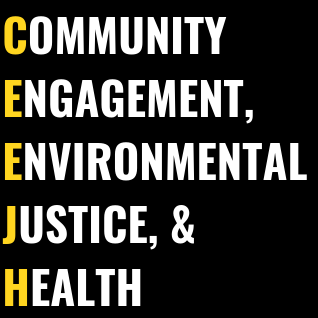Air Quality
Calls for more stringent regulation of air pollution is long overdue. In 2014, the World Health Organization reported that air pollution exposure killed an estimated seven million people worldwide--1 in 8 global deaths. 1 In the United States, communities of color (and especially Black and Latinx populations) are exposed to 63% more air pollution than they create. 2 Black children, in particular, are five times more likely to be hospitalized from asthma than White children.
As part of our action-based research to promote public health policy, CEEJH works with communities throughout Mid-Atlantic, the South, Gulf Coast, and southeastern United States to measure and communicate air pollution realities faced by overburdened and low-wealth populations of color.
Seeking to address concerns regarding air pollution related to local industrial activities and traffic, the goal of this study is to develop a hyper-local air quality monitoring network in Cheverly, MD.
The Ivy City Right to Breathe Partnership brings together members from grassroots organizations such as the Ivy City Civic Association and Empower DC, a neighborhood community, and universities including Howard University, the University of Maryland-College Park, Trinity Washington University, and George Washington University to work for Environmental Justice in a traditionally African American neighborhood in the nation’s capital.
Partnering with local community advocates Black Belt Citizens Fighting for Health and Justice, the CEEJH Lab has joined a multi-university academic research team that includes Yale University to provide technical assistance and environmental health literacy and to conduct citizen science training and research on air quality monitoring, soil sampling, water quality testing, and environmental risk reduction.
Buzzard Point in Washington, DC, is a neighborhood facing the brunt of urban environmental injustice. Through pollution from multiple sources and a lack of environmental amenities, residents have been exploited and drowned out to make way for further development.
Langley Park is a multicultural community composed of over 80% Latinxs with household incomes that are 83% lower than the rest of Prince George’s County.
In 2021, Charleston, SC will open a new marine container terminal that will add 1.4 million more containers each year, nearly doubling the port’s volume, and likely increasing air pollutants in nearby communities already disproportionately burdened by environmental hazards and poor air quality, as shown by prior research.
The transportation sector is the nation’s largest source of greenhouse gas emissions and other air toxics. Goods movement refers to the distribution of freight by all modes of transportation. There are serious public health concerns associated with goods movement, high truck traffic roads, and warehouses due to high levels of air pollution.
Many BIPOC communities throughout Prince George’s County are differentially burdened by exposure to traffic-related air pollution (TRAP) and environmental hazards associated with industrial activity. CEEJH is establishing a low-cost countywide air quality monitoring network to help fill in regulatory detection gaps in Prince George’s County.
Directly adjacent to Charleston, the one of the South’s most visited tourist destinations, lies an often overlooked African American community struggling to breathe. Instead of drawing countless tourists every year, North Charleston, SC is a major waypoint for goods movement and commercial shipping.
CEEJH, in collaboration with the Cheverly Town Council and Maryland Department of Environment, are establishing the first hyperlocal network of low-cost air quality monitor in the state. The network is hosted by community members concerned about traffic-related air pollutants in and around their neighborhoods.











